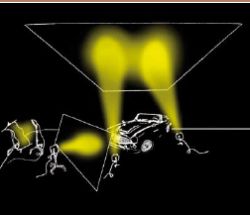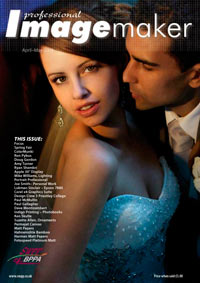articles/Lighting/slickandsexy-page1
Slick and Sexy Dave Montizambert makes a BIG light - part 1 of 1 2
by Dave Montizambert Published 01/04/2008

When a private collector of classic automobiles asked me to shoot his Austin Healy 3000 Mk III for an automobile art poster I was pretty excited. I was not just excited at getting to shoot such a beautiful car, but was excited because he asked for an art shot that would capture the emotion rather than the car, in other words, photograph the sizzle not the steak. As a starting point I chose a close-up of the Healy's front emphasising its beautiful chrome-work and decided that a little wide-angle distortion would help create more 'emotion'. The portion of the car I chose to shoot, as well as the wide-angle distortion, were only part of the equation, the strongest contributing factor to fulfilling the collector's requests was lighting - I wanted this image of the car to come across as slick and sexy.
If this car had been painted a lighter tone than black, such as white, you could get a serviceable image with an on-camera flash - wherever the curves and details of the car fall away from the flash-head, shadows will form. Since the shadowed areas would be darker than the white paint job, they would create contrast, helping us to see the beautiful curves of the bodywork
A shadow is an area of a subject that receives no illumination whatsoever from the main-light source; therefore it is an area of the subject where the subject's tonality is under-exposed. If black is the absence or near absence of all light then you have to ask yourself, can you under-expose black? If a tone is truly black, that is to say that it absorbs all the light hitting and returns none, or at least returns so little that it does not register on our image, then how could black, the darkest tone possible, be made any darker? Visually it cannot - a true black object does not register any darker in the areas that are not hit by the main-light than the areas that are. So all this to say that trying to show shape and form on a nearblack object by relying on shadows will render a poor image, there will be little to no contrast and definitely no 'slick and sexy'.
If I had lit the near-black Healy solely with an on-camera flash, we would see almost nothing of the car other than a few faint reflections of the dark studio walls on its surface plus several tiny burned-out hotspot reflections of the flash - in other words a black blob with a few white specks on it. For slick and sexy on this shoot I needed to forget about shadows and on-camera flash and think about another area of lighting that would create a suitable tonal contrast; somehow I needed to find a way to stretch those "hotspots" from the on-camera flash over the surface of the Austin Healy to show off its shape and form.
The sheen or shine we see wrapping around the curves of the Healy in Image 1 were created by strategically placed light sources. Sheen or shine is a layperson's term for a specular highlight (a mirror image of a light source seen as a reflection on the surface of the subject). The terminology people use for specular highlights can be pretty funny; you can usually tell how they feel about a particular specular highlight by how they refer to them. If they feel that the specular highlights in their photo are too intense, they generally call them hot spots or glare. If the intensity is just right, usually less intense, they refer to them as shine, sheen or, with one client of mine, wet-lines.
Size is relative - this is one of the most important factors in lighting that many of us overlook. Hmm, perhaps that might make a good reply back to many of those spam emails I've been receiving. Getting back to the on-camera flash scenario, an on-camera flash is a huge source of illumination to an ant but is a tiny source to a car. To light big dark shiny things you need big sources of illumination; only a relatively big source can create large enough specular highlights to wrap around and reveal a large object's curves and details. An Austin Healy automobile is approximately 12 feet or 4 metres long so a suitable light source for it would have to be more than 12 feet/4 metres on the long dimension.
You are currently on page 1
- Slick and Sexy Dave Montizambert makes a BIG light page 1
- Slick and Sexy Dave Montizambert makes a BIG light page 2
1st Published 01/04/2008
last update 09/12/2022 14:59:01
More Lighting Articles
There are 0 days to get ready for The Society of Photographers Convention and Trade Show at The Novotel London West, Hammersmith ...
which starts on Wednesday 15th January 2025





